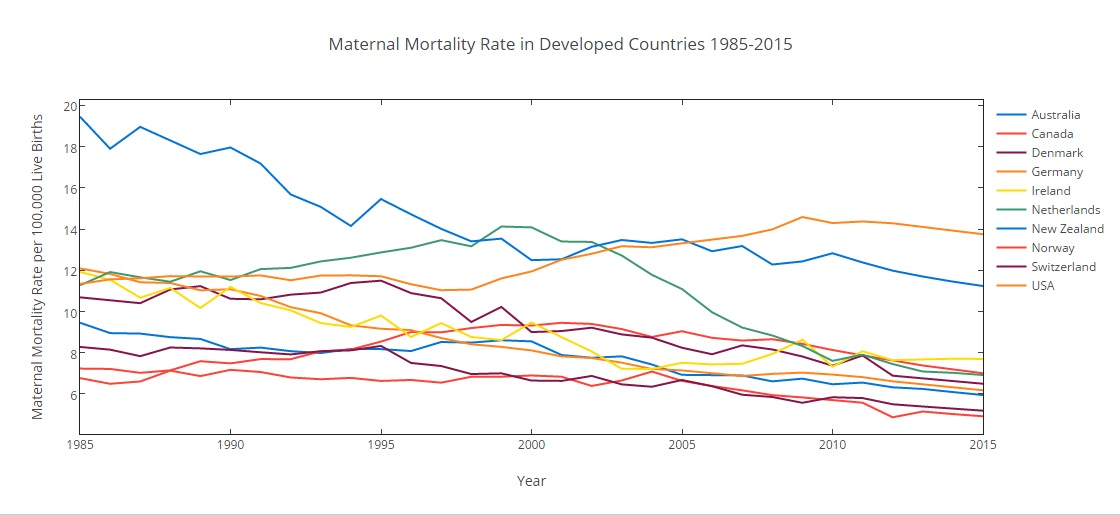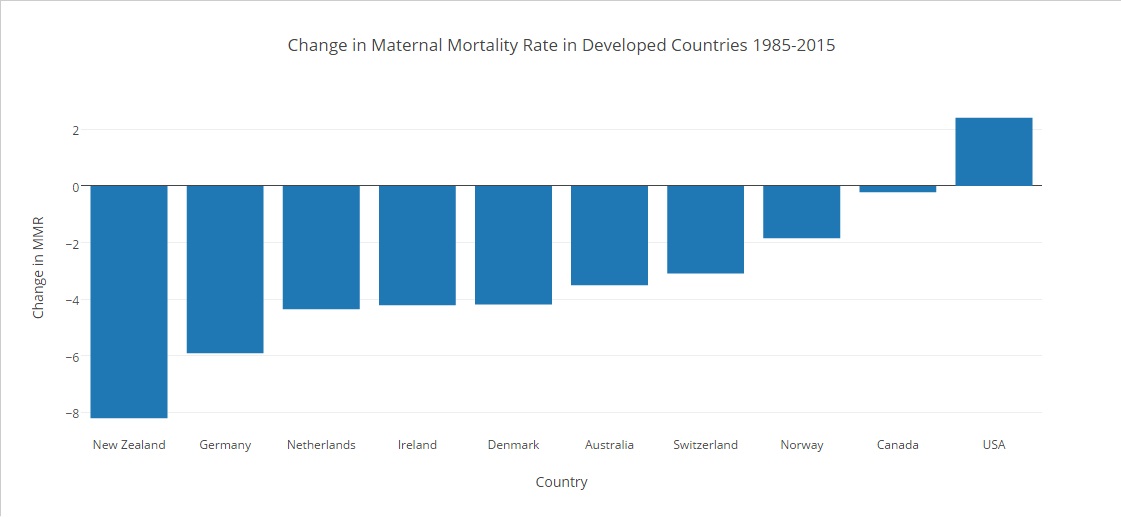More American women died due to pregnancy-related causes in 2015 than they did in 1985.
The United States is one of the wealthiest nations in the world, and in many ways, it is considered a leader among developed countries. Yet the nation’s maternal mortality rate reveals a striking contrast to its overall status.
About 14 women died per every 100,000 live births in the United States last year, according to data collected by the World Health Organization. The so-called “leader of the free world” ranked 46 out of 183 countries for which WHO provided maternal mortality data. That puts it just below Qatar (mmr = 12.6) and above Uruguay (mmr = 14.8).
To keep things in perspective, a maternal mortality rate of 13.7 is miniscule compared to other nations around the globe. Many countries in Africa had rates well above 500 in 2015. In Sierra Leone, about 1360 women died per every 100,000 live births – the highest maternal mortality rate in the world. Several Asian countries also had high rankings. Afghanistan came in 156th place with a maternal mortality rate of about 396.
But among developed countries, the United States is far behind. It not only has one of the highest maternal mortality rates, but it is also one of the only developed nations to have seen an overall increase in pregnancy-related deaths over the past 20 years. The maternal mortality rate in 1985 was 11.3. It fell to a low of 11.0 in 1997, but then made a relatively steady upwards climb, hitting a peak of 14.6 in 2009. While the rate has dropped to 13.7 since then, that figure remains 21 percent greater than the rate in 1985.
Among the top 10 developed countries in the world – as ranked by the United Nation’s Human Development Index in 2014 (the most recent data available) – the United States is the only one to have a worse maternal mortality rate today than it did two decades ago. In fact, in 2015, most of the top-10 HDI nations had maternal mortality rates below 8, or at least 40 percent lower than America’s.
Most of these countries have also seen their maternal mortality rates drop about three points in the last 20 years, while the United States has seen an increase of 2.4 points.
Experts say this surprising trend can be attributed to a number of factors.
Obesity-related complications is one of the leading causes of mortality in the obstetrics and gynecology field, Dr. Michael Brodman of Mount Sinai Health System in New York told CNN. Obesity is often accompanied by other diseases, like hypertension and diabetes, which put undue stress on the body. When a woman’s body is already adjusting to the myriad changes that come with pregnancy, additional stress can put her at risk.
Another concern in the United States is that women living in poor economic conditions often have less access to care. These are the women at greatest risk of developing pregnancy-related complications, yet they may be getting the least medical attention. This may account for the racial disparity in maternal mortality. Data from the Centers for Disease Control and Prevention shows that black women are more likely to die due to a pregnancy-related cause than white women. This often relates to the fact that more black women live in difficult economic conditions, and thus, avoid seeing doctors until later in their pregnancies due to the cost of medical visits.
CDC data also shows that there has been a dramatic increase in the number of cesarean section births in the last 20 years. One in three women had a c-section in 2014 (the most recent data available), up from 1 in 5 two decades ago. Some doctors speculate that this surge is a result of physicians growing increasingly concerned about getting sued. They are less likely to wait for natural birth in potentially risky situations today than they may have been in the past. This can lead to higher maternal mortality rates since surgery always carries a risk for the mother and child.
Many experts also point to the trend of women waiting till later in life to get pregnant. Older women are more likely to have chronic diseases that can put them at risk during pregnancy. Many studies have shown that a growing number of pregnant women in America suffer from hypertension, diabetes, and chronic heart disease – all conditions that increase the chance of pregnancy complications.
Record-keeping changes might also account for some of the upward trend. Nowadays there is a box for pregnancy-related deaths on the standard United States death certificate used in most states. This didn’t exist 20 years ago, so the maternal mortality rate may have been underreported.
This combination of factors may be uniquely American. Most other countries that experienced an overall increase in maternal mortality rate from 1985 to 2015 have much higher rates than the United States. These include the Bahamas, Guyana, Saint Lucia, and Tonga – all small island nations, with the exception of Guyana, which is a country on the North Atlantic coast of South America, whose population is less than 100,000.
These countries saw much larger increases in maternal mortality than the United States. Guyana saw its rate jump from 175.4 in 1985 to 228.8 in 2015.
Serbia – possibly the most comparable of these nations to the United States – saw an increase of only 0.01 points. But as a relatively small country on Europe’s Balkan peninsula, it is still not a great comparison to America.
It seems America will need to find a unique strategy to lower its maternal mortality rate. Until it does, the nation will have a dark spot on its record of vital health statistics.





